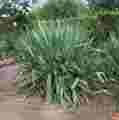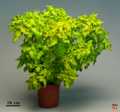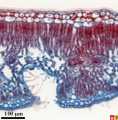Major differences exist in both shape (morphology) and inner architecture (anatomy) of leaves between various plant species.

Diversity: monocots versus dicots
Based on morphological, genetical and other characteristics, plants have been divided into taxonomical groups. One important division in the order of the flowering plants (Angiosperms) is that in monocots and dicots. More on the leaves of
monocots (examples: maize, papyrus and Joshua tree) and
dicots (examples: coleus, ivy and lilac).
| Leaf: monocots versus dicots |
 |
 |
 |
Monocots:
maize
papyrus
Joshua tree (Yucca brevifolia) |
 |
 |
 |
Dicots:
Coleus
ivy
lilac |
Suggestions for tasks on the diversity in structure among leaves:
-
Compare the leaf of corn (Graminea) as an example of a monocot with that of lilac (Oleaceae) as a representant of dicots.
- Prepare a paper about the anatomical and morphological differences between leaves of mono- and dicots. Use for this purpose the pages under the links Monocots, Dicots and Leaf formation.
- Describe the similarities and differences in leaf anatomy and morphology between two monocotyl plants maize and yucca. Make, for example, a table and explain in which climatic zone you would expect to find each of these two species. Information for this task can be extracted from the clickable images under the link Monocots
- Make a poster of the relationship between leaf anatomy and various types of climates / environmental conditions. Use the pages under the links from Environmental adaptations to Submerged waterplants.
Diversity: adaptations tothe environment and the climate
Beside above mentioned taxonomical differences, plants have developped all kind of adaptations to various climatical and environmental conditions.
The abiotic (not bound to living organisms) factors, e.g. temperature, relative huimidity, soil condition and ultraviolet and heat radiation, may be very different depending on the location on earth and the time of the year. A marsh plant in winter time will need completely different strategies to survive than a desert plant in summer. To maintain essential live functions like photosynthesis and internal transport of water and nutrients, plants exhibit all kinds of ingenuous adaptations. In addition, protection agains predators (biotic factor) may be needed.
In the next pages we will further examine the following groups:
| Type of leaves and environmental conditions |
Leaves with so-called mesomorphic characteristics are found in areas with a moderate climate with regular rainfall. Examples of plants with such leaves are lilac (picture) and petunia.
More about leaves of mesomorph plants.
|
 |
Xeromorph (Gr. xeros=dry and morph=shape) species can live in a very dry environment. These plants are adapted to high levels of solar radiation, great shifts in temperature, and of course, periods of drought. They are able to absorb sufficient amounts of water from the soil through their commonly deep roots. An example is the Mediterranean shrub Nerium oleander.
More about leaves of xeromorph plants.
|

|
Succulents are often encountered in regions with a desert climate, where the rainfall is irregular and restrained to short periods. These plants take up a large amount of water after a rain shower and store the water in their leaves or stems. Example: the common pot plant, Crassula ovata.
More about leaves of succulents.
|

|
Hygromorphic plants preferably grow on a very wet soil, on a shady location where the relative humidity is high and there is always ample supply of water. An example is the greater creeping spearwort (Ranunculus flammula).
More about leaves of hygromorph plants.
|

|
Some higher plants float on the water surface, like the water lily (Nymphea alba)
More about leaves of floating plants.
|

|
Other water plants are completely submerged, for example the Canadian waterweed (Elodea canadensis).
More about leaves of submerged plants.
|

|







